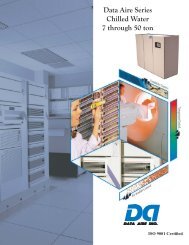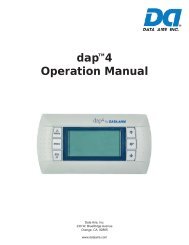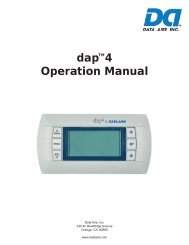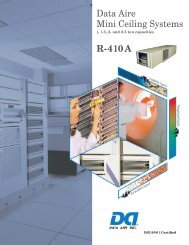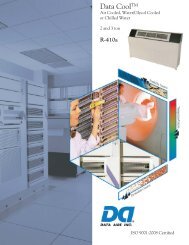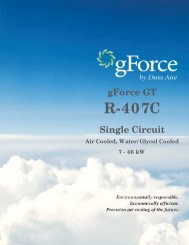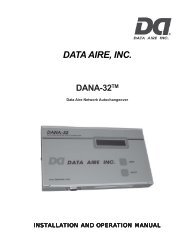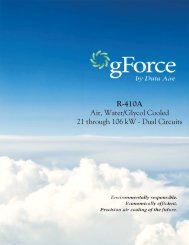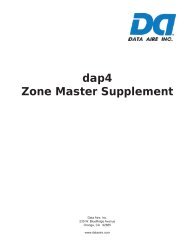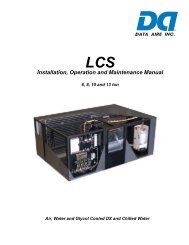Installation, Operation and Maintenance Manual - Data Aire
Installation, Operation and Maintenance Manual - Data Aire
Installation, Operation and Maintenance Manual - Data Aire
Create successful ePaper yourself
Turn your PDF publications into a flip-book with our unique Google optimized e-Paper software.
(DRCU), the superheat should be 20 to 25°F at the compressor. Remove any block that may<br />
have been used on the condenser coil. If the ambient temperature while charging is below 70°F,<br />
some of the refrigerant will be backed up into the condenser coil causing the liquid level in the<br />
receiver to drop (this is normal).<br />
NOTE: Charging to a full liquid line sight-glass should never be the sole means of determining<br />
the correct refrigerant charge. Other parameters such as superheat, suction<br />
pressure, head pressure, sub-cooling <strong>and</strong> ambient temperature are also important. A<br />
system charged to a clear sight-glass is often overcharged.<br />
5.3 Water/Glycol Cooled Systems<br />
5.3.1 Water/Glycol Cooled System Charging<br />
All water/glycol cooled units are factory charged with refrigerant. The water regulating valve<br />
should be adjusted to maintain a condensing temperature of 105 to 119°F. Saturated suction<br />
temperature should be 33°F or higher. The superheat at the compressor suction line (measured<br />
at least 6 inches away from the compressor) should be 8 to 15°F.<br />
Field charging water/glycol systems (if required) should be done by referring to the unit’s electrical<br />
nameplate. The factory charge is indicated on the nameplate. Although this value represents<br />
the original factory charge, it is still necessary to measure <strong>and</strong> note proper unit operation including<br />
superheat, head <strong>and</strong> suction pressure. Some adjustment to the refrigerant may be required.<br />
Adjust the refrigerant charge until the sight-glass clears or has sparse bubbles. The unit should<br />
be allowed to stabilize for several minutes before meaningful measurements can be taken <strong>and</strong> the<br />
conditioned space should be at or near the temperature setpoint.<br />
All water/glycol cooled units have a water regulating valve. A head pressure sensing transducer is<br />
connected to a shrader fi tting on the discharge line <strong>and</strong> water is regulated into the condenser coil.<br />
St<strong>and</strong>ard condensers are plate fi n type.<br />
WARNING: Before starting a compressor, the crankcase heater should be energized<br />
for a minimum of 12 hours to reduce the possibility of liquid slugging on start-up. Failure<br />
to energize the crankcase heater could result in compressor damage. If the system<br />
is charged from a vacuum, the pre-heating of the compressor is not necessary.<br />
NOTE: Charging to a full liquid line sight-glass should never be the sole means of determining<br />
the correct refrigerant charge. Other parameters such as superheat, suction<br />
pressure, head pressure, sub-cooling <strong>and</strong> ambient temperature are also important. A<br />
system charged to a clear sight-glass is often overcharged.<br />
5.3.2 Factory Charge for Water/Glycol Cooled Systems<br />
Evaporator Model R-407C R-410A<br />
DAPW/G 2.5 Consult Factory Consult Factory<br />
DAPW/G 03 Consult Factory Consult Factory<br />
DAPW/G 04 Consult Factory Consult Factory<br />
DAPW/G 05 Consult Factory Consult Factory<br />
26



